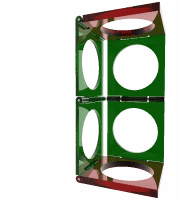 | ||
The Sarrus linkage, invented in 1853 by Pierre Frédéric Sarrus, is a mechanical linkage to convert a limited circular motion to a linear motion without reference guideways. The linkage uses two horizontal plates (red) positioned parallel to each other, one over the other. Two rectangular plates (green) with hinges at the middle connect the horizontal plates. The circular arc motion of a hinge produces a linear vertical movement. The upper plate moves vertically up and down, towards and away from the lower one. The Sarrus linkage is of a three-dimensional class sometimes known as a space crank, unlike the Peaucellier–Lipkin linkage which is a planar mechanism.
Although Charles-Nicolas Peaucellier was recognized for being the first to invent such a straight-line mechanism, the Sarrus linkage was invented earlier; it went, however, largely unnoticed.
